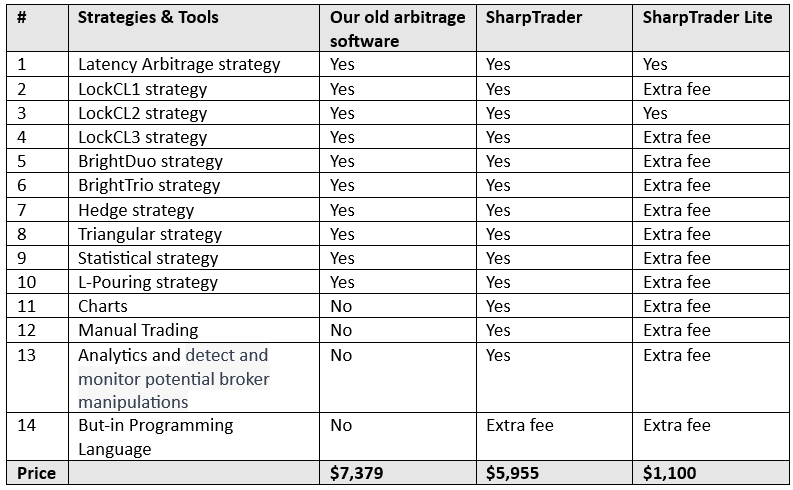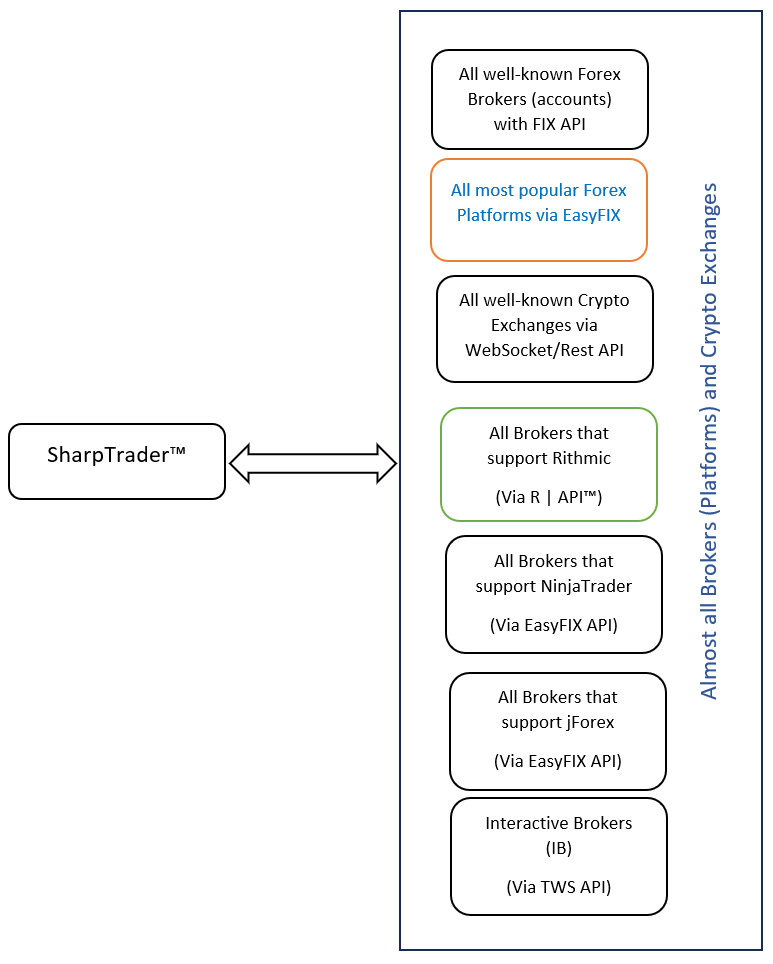SharpTrader: Comparing Lite, Full Versions, and Old Lock Latency Arbitrage Software 2023年10月13日 – Posted in: Arbitrage Software, cryptoarbitrage software – Tags: easyfix, forex arbitrage software, latency arbitrage software, lock arbitrage, sharptrader
In the fast-paced world of trading, software tools play a pivotal role in determining success. SharpTrader, with its advanced algorithms and innovative features, has set a benchmark. However, with multiple versions available, traders often need help deciding which one to choose. This article breaks down the differences between SharpTrader Lite, SharpTrader Full, and the Old Latency Arbitrage software to provide a clear picture.

SharpTrader Full Version
Features
- Strategies: This comprehensive version is loaded with multiple strategies, including Latency, LockCL1, LockCL2, LockCL3, BrightDuo, BrightTrio, Hedge, Triangular, Statistical, and L-Pouring.
- Advanced Analytics: One of its standout features is the capability to detect and monitor potential broker manipulations, ensuring that traders always stay a step ahead.
- Comprehensive Charting: With an array of charting tools, traders can analyze market trends with precision.
- Manual Trading: Apart from automated strategies, traders have the flexibility to make manual trades, tailoring their approach based on real-time insights.
Learn more about SharpTrader full version
SharpTrader Lite Version
Features
- Strategies: A simplified version, SharpTrader Lite offers the Latency and LockCL2 strategies, making it easier for traders to navigate.
- Novice-Friendly: With the omission of features like analytics, monitoring of broker manipulations, charts, and manual trading, this version is tailored for those new to the trading scene or those who prefer a more straightforward experience.
Learn more about SharpTrader lite version
SharpTrader Full version and SharpTrader Lite version both contain EASYFIX API
Understanding SharpTrader’s EASYFIX API
Most standard trading terminals and online platforms offer connections to only a single broker server. SharpTrader, however, breaks this mold. It employs a streamlined version of the FIX protocol, dubbed EASYFIX, to establish connections with various exchanges and brokers via bridges. These connectors to exchanges or brokers are kept separate in individual bridge infrastructures, and for good reasons. In this space, a “bridge” is software designed to link up with cryptocurrency platforms, financial exchanges, or broker servers. Let’s delve into the rationale behind keeping separate bridges for distinct exchanges or brokers.

Benefits of Distinct Bridges:
- Risk Containment:
- Each exchange can come with its challenges, including vulnerabilities, operational hiccups, or even downtimes. By using distinct bridges for individual exchanges, potential issues with one won’t spill over to others, thus containing risks.
- Redundancy and Continuity:
- Separate bridges mean more effective redundancy and failover systems. If one bridge faces issues, others remain unaffected, ensuring trading continuity.
- Tailored Customization:
- Exchanges can differ in APIs, trading rules, or even order types. Separate bridges allow customizations specific to each exchange, leading to more efficient trading.
- Scalability:
- As you expand your trading horizons or integrate more exchanges, distinct bridges simplify scaling. New bridges can be introduced without disrupting existing structures. Additionally, through the EASYFIX protocol, you can even craft your bridge and link it with SharpTrader. A noteworthy perk here is the potential to house the Bridge and SharpTrader on separate servers, offering a layer of stealth to your arbitrage strategies.
- Enhanced Security:
- Financial and crypto markets demand robust security. Distinct bridges mean specific security protocols can be deployed for each exchange, reducing overarching security threats. It also aids in adhering to exchange-specific regulations.
- Optimized Performance:
- Every exchange can vary in trading volumes or API response rates. Individual bridges permit tailored architectural and resource optimization for each, ensuring efficient trading.
- Minimal Latency:
- A local TCP socket connection to a bridge on the same PC offers negligible latency, usually less than a millisecond. Since the data doesn’t navigate through an external network, delays are virtually non-existent. Modern computers’ high-speed connections further diminish latency.
- Streamlined Troubleshooting:
- Should there be a connectivity or API issue with an exchange, an isolated bridge makes the troubleshooting process smoother and swifter.
Final Thoughts:
Choosing to maintain distinct bridges for each exchange or broker isn’t just a wise move. It’s a strategic approach offering multiple advantages from risk management and performance optimization to enhanced security and scalability. Such a modular system is widely acknowledged as a best practice in the realm of algorithmic trading and fintech.
Old Lock Latency Arbitrage Software
Features
- Strategies: Much like the SharpTrader Full, the Old Latency Arbitrage software boasted a gamut of strategies, making it versatile.
- Pricing: This software was more expensive than its successors, which may have been a deterrent for some traders.
- Limited Tools: Unlike SharpTrader Full, it lacked the advanced analytics, the ability to detect and monitor broker manipulations, charting tools, and manual trading.
Conclusion:
While all three versions come with their unique offerings, the choice boils down to individual trading needs and budget. For those looking for a comprehensive tool with a plethora of features, the SharpTrader Full Version is ideal. Novices, on the other hand, might find the Lite version more apt. The Old Latency Arbitrage software, despite its robust strategies, falls short in terms of advanced features and was pricier. In the ever-evolving world of trading, it’s essential to have a tool that aligns with one’s goals, and with SharpTrader, there’s something for everyone.
Arbitrage Trading Education program – Join now!
 English
English Deutsch
Deutsch العربية
العربية 한국어
한국어 Español
Español Português
Português Indonesia
Indonesia Tiếng Việt
Tiếng Việt 中文
中文
